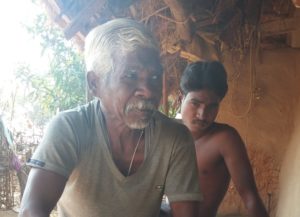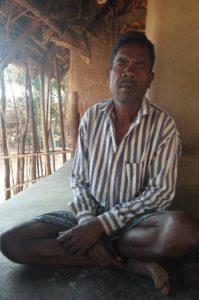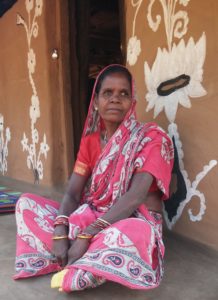These are the stories of the Honey Hunters of the Similipal Biosphere Reserve, the Mayurbhanj Distict, of Orissa. The honey hunters hail from the various tribal groups of the Nilgiris Biosphere Reserve and for several of the indigenous groups their histories and traditional practices have been recorded, albeit with some missing information but nevertheless documented. However, the purpose of these anecdotes is to show the personal narratives of each honey hunter and their own distinct experience; to go outside the limitations of textbook information and read about personal accounts. To understand a certain group of people it is necessary to have anthropological information and it is equally important to know the stories of individuals within that group. A few of the simple questions that were asked included: What is your favorite/most memorable moment from honey hunting? Why do you continue honey hunting? Will this tradition continue? Have you noticed any changes in this practice? Below are the summations of their answers; sometimes there is a common thread response and other times an individual gives a completely unique account.
Surendra Dehuri
 He is a honey hunter that comes from a village called Gandiadar, found at the edge of Simlipal National Park in Orissa. Around the age of 15-16 he began honey hunting and was taught by his father. He has been doing this traditional trade for 50 years now and there was a time when he used to go honey hunting with his wife and two sons. Yet, nowadays his wife no longer goes honey hunting and his two sons had to migrate to Gujarat in order to earn money. It is possible to collect honey for 6-7 months, along with other NTFPs (Non Timber Forest Products), however for the rest of the year there is little to no work so several of the young generation have had to migrate to make a living. Nonetheless, he continues to honey hunt because it is his livelihood and traditional duty.
He is a honey hunter that comes from a village called Gandiadar, found at the edge of Simlipal National Park in Orissa. Around the age of 15-16 he began honey hunting and was taught by his father. He has been doing this traditional trade for 50 years now and there was a time when he used to go honey hunting with his wife and two sons. Yet, nowadays his wife no longer goes honey hunting and his two sons had to migrate to Gujarat in order to earn money. It is possible to collect honey for 6-7 months, along with other NTFPs (Non Timber Forest Products), however for the rest of the year there is little to no work so several of the young generation have had to migrate to make a living. Nonetheless, he continues to honey hunt because it is his livelihood and traditional duty.
During his lifetime as a honey hunter he has taught 60-70 people. There was a time when he and the other honey hunters would let children accompany them on the honey hunt so that the young ones could observe and learn. The forest department even used to watch over their children in the forest while they would collect NTFPs. In the beginning he used to collect honey by burning hives directly with fire. Yet this was killing the colonies, so now he and others of his village have switched to using smoke only and less bees are killed. This change of technic has even increased the quantity of honey and more hives can be found closer to the village as opposed to only deep in the forest. Yet, even with the increase of honey and the higher prices it affords, there is less honey collected because there a more restrictions from the forest department in allowing people to go into the forest and gather NTFPs. Thus, Surendradehuri does not know if the honey hunting tradition will continue with the next generation. The young people, like his sons, have interest to learn but they can’t afford to live there without better access to the forest.
Even against these odds he considers this practice very important and significant to his village deity. Before a honey hunt he and his team will do a pooja for the purpose of protection from wild animals. By praying to village the deity, he says there have been no animal attacks or bee stings. And in general he is proud of his community and then honey hunting that they do.
Chaitanya Katul

He has been honey hunting for 35 years and began this ancestral trade when he was 20. He was taught by his father, mother, and brother. He himself has taught 6 other people these traditional skills, out of which 3 have become master trainers of honey hunting in the village. When he goes for a honey hunting expedition, he will go to the forest with a large group of people. There they will sit and discuss the strategies, then the group will divided into smaller groups that often comprise of family and sometimes other village individuals. For him, this practice is a means of livelihood and even a good business because it does not a person having to invest money, one simply needs access and trained skill in the forest.
There have been a few changes to the collection strategy since he became a honey hunter. For instance, he used to cut down the entire honey comb and squeeze out the contents, which often included larva and other pieces of the comb. An entity intervened on the behalf of the bee survival and taught the honey hunters, such as Chaitanya, how to cut only the honey section out comb and squeeze only honey portion. This not only ensures that the honey collected is more hygienic but is also more sustainable for the honeybees. Honey was once collected into pots and oil cans, and within the latter the honey would be made to smell bad; and the honey is collected with plastic containers.
He has also had his fair share of risky encounters in the forest when going for a honey hunt. For instance, one morning he went to the forest with his uncle and few other honey hunters. On the way they encountered an elephant, which started chasing them and everyone scattered in fear. Chaitanya then found himself alone in the forest, without his shoes or food he brought for the expedition. Once he finally found his friends, the elephant had gone to the river for a bath. So they were able to return to their honey hunting work and bring honey home safely to their families. His wife took some of the honey and cooked it with rice for the children and the rest was sold at the market. A positive outcome to such risky business.
Phaguni Katual

After getting married she began honey hunting; she is now 45 but doesn’t know they age she married and started this forest vocation. Both her father and brother taught her the necessary skills, and she herself has taught 4-5 this traditional practice. She continues honey hunting for the purpose of earning money for her family. Honey hunting is also her habit. Often her son will accompany her during the honey season. She will even climb the trees to collect to face the buzzing hives and collect the honey.
Like almost every other honey hunter in the village, she has encountered wild animals in the forest. One day she had gone to the forest for honey collection and saw an elephant from far away, to which she became afraid and ran away. While running she ripped her clothing and ultimately returned to the village without honey. Sometimes, these excursions are botched by factors that cannot be controlled.
Kasturi Palei
 She says the forest is her life and without the forest she cannot live. That is one reason she continues honey hunting and has been doing so for the last 25 years. It is a way not only to support her family but to also earn money. She fulfills several roles as a honey hunter, from climbing the tree and cutting down the comb to helping give tools to her husband while on the ground. Over the years that she has honey hunted there have been some changes, such as mud pots to collect the honey being replaced by plastic containers.
She says the forest is her life and without the forest she cannot live. That is one reason she continues honey hunting and has been doing so for the last 25 years. It is a way not only to support her family but to also earn money. She fulfills several roles as a honey hunter, from climbing the tree and cutting down the comb to helping give tools to her husband while on the ground. Over the years that she has honey hunted there have been some changes, such as mud pots to collect the honey being replaced by plastic containers.
Even the quantity of honey has changed, having increased over the years; yet even with this fortunate growth, the honey collection has reduced. This is due to the forest department incurring more restrictions on the honey hunter communities. Even still she believes this ancient practice will continue with the younger generation, not only her son but also grandson.
Parvati Diegar

Parvati is a member of the village called Junpaleodadiha, which is also at the edge of the Simlipal National Reserve and part of the Khadia tribe. She is not sure how old she is but estimates to be in her 60s and possibly has honey hunter for 30-40 years. Parvati was taught by her husband how to honey hunt and later taught her son the skills of this ancient practice; he is only individual she has taught. For her, honey hunting is a means to earn money for her and her family, especially with supporting health costs. Often the group she goes to honey hunt with are her family and a few other villagers. In the group she does not climb the trees but will help her husband with tasks on the ground below.
Like others before and in her village, she has experienced dangers when going to collect this NTFP from the forest. After completing a honey hunting session one season, she and the other honey hunters took rest for the night in the forest. All the honey hunters were sound asleep when a tiger suddenly came and attacked her husband. The husband cried out and the others instantly woke; they quickly attacked the tiger with burning sticks and axe until the tiger went away. Fortunately the husband came out of the situation unharmed and the group even stayed sleeping there in the forest that night. However, this sort of good fortune with wild animals is not always the case and there are plenty of instances when honey hunters have come out scathed, even fatally, after such instances. Parvati also recalled a story of two men from her village who had been attacked and killed, which even caused honey hunting to decrease. Even against the risks she has faith that the children of the village with continue honey hunting. In fact, she related a memory of a group of children who were told to practice their school work and instead laid their slate at the bottom of a tree then climbed the tree for money. At least, the interest in these ancestral practices is still steadfast.




